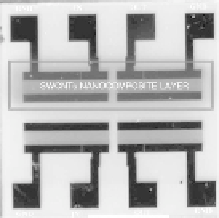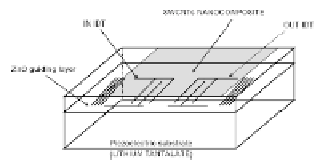Biomedical Engineering Reference
In-Depth Information
Penza
. [291] demonstrated an advanced SAW sensor
configured as Love wave using a ZnO guiding layer on 36° Y-cut
X-propagation
et al
piezoelectric substrate, designed and
fabricated for toxic gas sensing applications, at room temperature.
SWCNT-based nanocomposite coatings were deposited using the
Langmuir-Blodgett technique. The sensor was tested toward H
LiTaO
3
,
2
NH
gases, in the range of 0.030-1%, 30-1000 ppm, 1-10 ppm,
respectively. The output signal was the phase of the SAW device,
which was monitored using a network analyzer. The developed sensor
exhibited high sensitivity, good repeatability, and low detection limit
at sub-ppm levels, at room temperature. The experimental results
obtained were compared to a theoretical model and the gas sensing
mechanisms were discussed with the acoustoelectric effect that
appeared to be dominant in the SAW response.
, NO
3
2
Figure 9.38
(
) Photograph of the dual 69 MHz two-port resonator
integrated onto lithium tantalate substrate. (
Left
Right
) Scheme of
the ZnO/LiTaO
layered SAW two-port resonator gas sensor
with CNT-based nanocomposite LB film as gas-sensitive
layer. This figure is reprinted and adapted with permission
from Elsevier [291].
3
These SAW devices (see Fig. 9.38) were two-port resonators
fabricated on a 0.5 mm thick 36° YX LiTaO
substrate. The IDTs
consisted of 38 finger pairs in each port. The 160 acoustic reflectors
with a periodicity (wavelength) of 40
3
m at each end of the device
were used to create a resonant cavity. The metallization pattern
consisted of a 20-nm Ti layer followed by a 80-nm Au layer. The
center-to-center separation between IDTs was 48
µ
λ
with an aperture
of 700
m
which results in the largest electromechanical coupling coefficient
for this structure. For our device, the 36° Y-cut, X-propagation
LiTaO
µ
m. The thickness of sputtered ZnO guiding layer was 1.2
µ
substrate allows the propagation of shear waves. The shear
3




